Tim Peake runs the Virgin Money London Marathon today while tethered to a treadmill in space aboard the International Space Station 400 kilometres (248 miles) above the Earth’s surface. He will be taking the long-distance race literally out of this world.
By running the 26.2-mile event at the same time as 37,000 other runners, but in a weightless environment, the British astronaut will ‘boldly go where no man has gone before’.
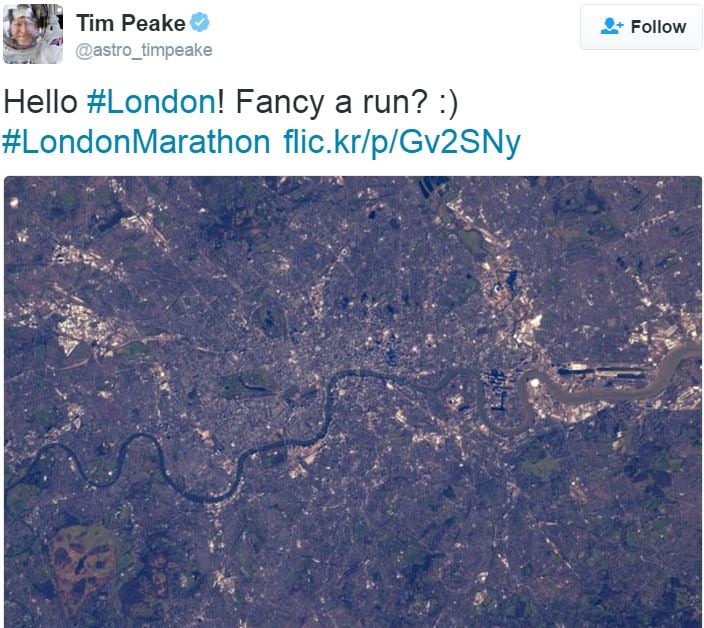 Our man in space, Major Tim Peake, is clearly keen on competing in the Virgin Money London Marathon 2016. When he woke up this morning, he sent this message to people back home on the ground. (Image: twitter.com/astro_timpeake)
Our man in space, Major Tim Peake, is clearly keen on competing in the Virgin Money London Marathon 2016. When he woke up this morning, he sent this message to people back home on the ground. (Image: twitter.com/astro_timpeake)
Tethered to a treadmill
Unlike his competitors pounding the streets of London, Major Peake will be wearing a harness, tethered to his running machine. If he tried to do the race with no tether he would simply float into the air after his first step.
The Chichester-born spaceman has been preparing for this challenge for the past seven years – ever since he was one of six candidates, out of 8,413 applicants, who was accepted into the European Space Agency’s astronaut training programme.
Regarding his long-standing dream to compete in the London Marathon from space, Major Peake said:
“As soon as I got assigned to my mission to the ISS, I thought, ‘Wouldn’t it be great to run the Digital Virgin Money London Marathon from onboard the ISS?’. The London Marathon is a worldwide event. Let’s take it out of this world.”
“I ran the London Marathon in 1999 and loved every minute of it. I was blown away by the energy and the enthusiasm of everyone involved, so when I heard that I’d be going to the ISS in December 2015 I asked the medical team if I could run the 2016 London Marathon in space on the same day that everyone will run it on Earth. I was thrilled when they said yes; I’m sure it will be one of the highlights of my mission.”
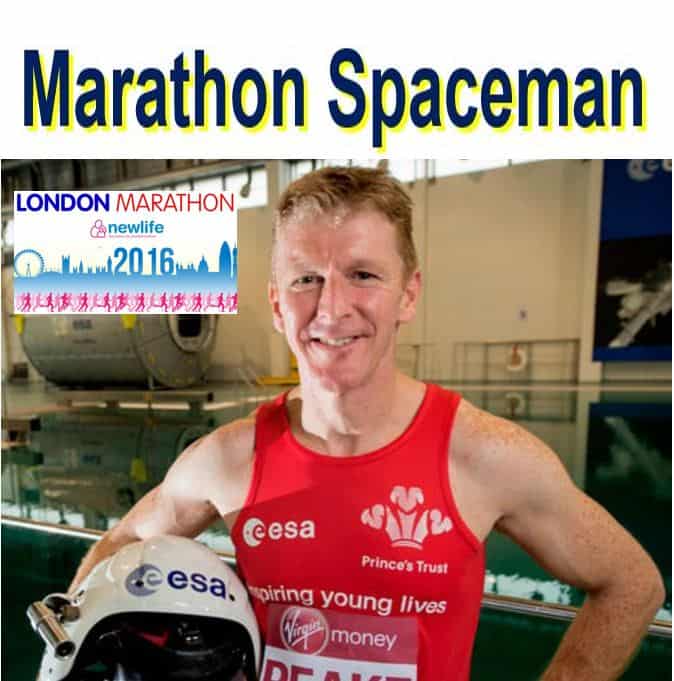 Major Peake has been planning for this big day since 2009, when he was selected, together with 6 other candidates, for the European Space Agency’s astronaut training programme. (Image: European Space Agency)
Major Peake has been planning for this big day since 2009, when he was selected, together with 6 other candidates, for the European Space Agency’s astronaut training programme. (Image: European Space Agency)
The treadmill in space
The ISS treadmill works much in the same way as the devices back on Earth. In space, there is no gravity and things float around if you do not attach them to the wall, floor or ceiling, so Major Peake wears a harness that tethers him down.
While competing in the event he watches an HD video of the course on a screen. As the British astronaut explains, he will not be running alone:
“The thing I’m most looking forward to is that I can still interact with everybody down on Earth. I’ll be running it with the iPad and watching myself running through the streets of London whilst orbiting the Earth at 400km above the surface and going 27,000km per hour.”
The ISS treadmill is nowhere near as nice as the ones he is used to using back on Earth. The one he runs on in space is in the corridor next to the astronauts’ toilet. When ISS crew members run on it they have nothing but a blank wall to stare at.
Major Peake’s harness
Major Peake makes the following comment regarding the rucksack-like harness he has to wear:
“One of the biggest challenges I’ll face is the harness system. In microgravity I would float if I didn’t strap myself down to the treadmill so I have to wear a harness system that’s similar to a rucksack.”
“It has a waist belt and shoulder straps, which have to provide quite a bit of downforce to get my body onto the treadmill, so after about 40 minutes that gets very uncomfortable.”
The European Space Agency’s (ESA’s) Space Medicine Office, led by Dr. Jonathan Scot, determine how much force Major Peake’s harness must have in order to make conditions as similar as possible to those back at home.
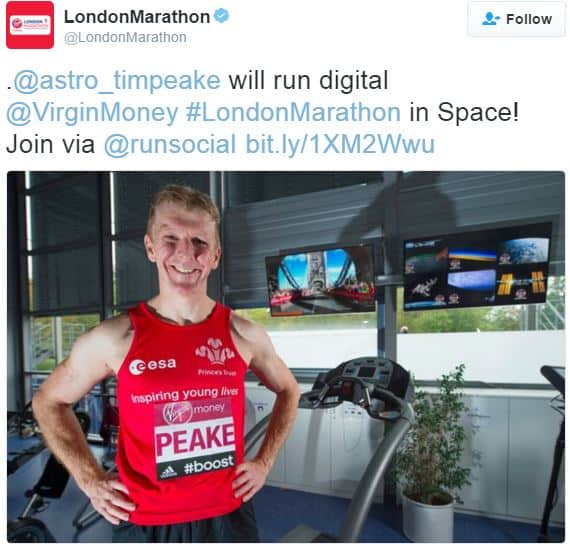 Millions of people across the United Kingdom and the rest of the world will be following Tim Peake’s progress during the London Marathon online. (Image: twitter.com/LondonMarathon)
Millions of people across the United Kingdom and the rest of the world will be following Tim Peake’s progress during the London Marathon online. (Image: twitter.com/LondonMarathon)
Dr. Jonathan Scott, leader of the Medical Projects and Technology Team, Libby Jackson, Astronaut Flight Education Programme Manager for the UK Space Agency, and other members of Team Atronaut will be wearing replica space suits for the London Marathon challenge.
If the scientists opted for minimal harness force, just enough to stop Major Peake from floating away, he would definitely win the 26.2-mile event, and probably in record time. It would be like being able to run on Earth with his current muscular strength and level of fitness but just one tenth of his body weight.
Major Peake wants to compete under the same conditions as his counterparts down on the ground. “I don’t think I’ll be setting any personal bests. I’ve set myself a goal of anywhere between 3:30 to 4 hours,” he commented.
Good luck message from @astro_timpeake to #teamastronaut and everyone running #LondonMarathon https://t.co/hGoFXkAcae
— ESA (@esa) April 24, 2016
The Prince’s Trust
Major Peake, who became a Prince’s Trust ambassador last year, is running the event to raise money for the charity, which helps young people across the UK.
The Prince’s Trust, which was founded by the Prince of Wales in 1976, makes the following statement on its website:
“We believe that every young person should have the chance to succeed. So, we help 13 to 30 year-olds who are unemployed or struggling at school to transform their lives.”
Team Astronaut, including our man in space, are all raising money for the Prince’s Trust.
Regarding the Prince’s Trust, and why he has become involved in helping the charity raise money, Major Peake said:
“As a young child, I dreamed of becoming an astronaut. Since then, with fantastic support from others, the right opportunities, and a lot of hard work, I now find myself on the brink of achieving my early dreams.”
“But I know I am one of the lucky ones. Thousands of disadvantaged young people in the UK need even more support from us to get the chance to follow their dreams and fulfil their potential.”
“It’s an amazing organisation that helps young people succeed in life no matter what their background. The young people helped by The Trust face innumerable challenges and difficulties in their daily lives, and so it’s all the more important that they get the opportunity and support to develop their abilities and realise their talents.”
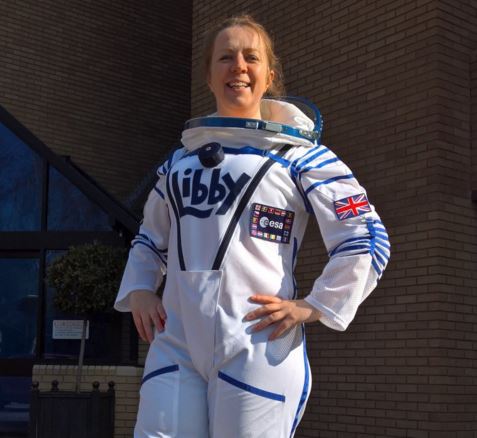 Libby Jackson in her replica Sokul running astronaut suit, a Team Astronaut member, runs in the London Marathon today wearing that suit. Team astronaut includes employees of the UK Space Agency and the European Space Agency who will be running with Tim Peake to raise money for the Prince’s Trust. (Image: spacetoearthchallenge.org.uk)
Libby Jackson in her replica Sokul running astronaut suit, a Team Astronaut member, runs in the London Marathon today wearing that suit. Team astronaut includes employees of the UK Space Agency and the European Space Agency who will be running with Tim Peake to raise money for the Prince’s Trust. (Image: spacetoearthchallenge.org.uk)
He hopes his performance during the long race today will not only promote The Prince’s Trust work, but will also serve as inspiration for the next generation of athletes and scientists.
Major Peake said:
“The London Marathon is a fantastic event. It brings people together not just from all around the UK but from all around the world. It’s also a lot of fun and the atmosphere is just outstanding. I can’t wait to feel part of the 2016 race. Good luck to everybody!”
A keen runner since childhood
Major Peake, who discovered running after joining the Army Cadet Force while still at school, has been passionate about the sport ever since.
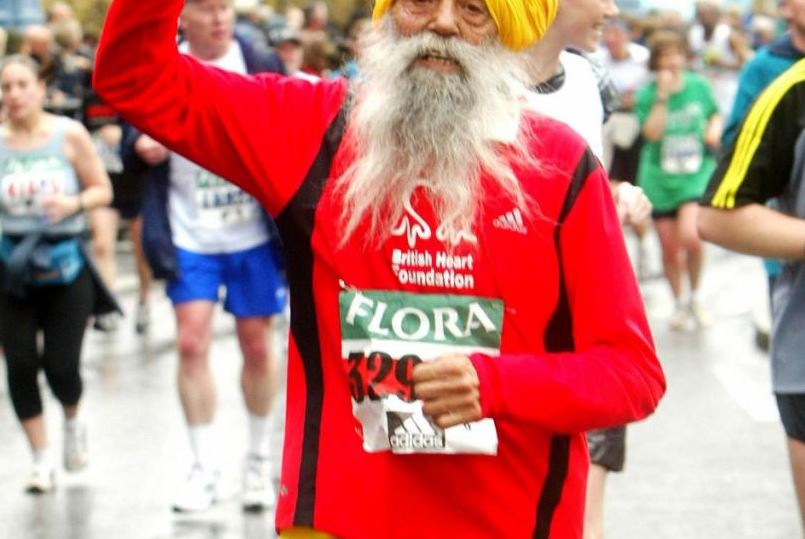 The London Marathon is an event for people of all ages and levels of ability and disability. In this image you can see Fauja Singh, 101 years old, competing in the 2012 event. (Image: London Marathon)
The London Marathon is an event for people of all ages and levels of ability and disability. In this image you can see Fauja Singh, 101 years old, competing in the 2012 event. (Image: London Marathon)
He said:
“I got into running as a teenager after joining my school’s Army Cadet Force. I loved all the outward-bound activities, but especially cross country running around the South Downs where I grew up. I’ve enjoyed trail running ever since.”
“Staying fit was part of the job when I was an Army Air Corps test pilot, so I would run outdoors three or four times a week. In my career as an astronaut I have to spend a lot of time on the treadmill, but if I was given the choice I’d always choose to run outdoors cross country.”
During a press conference just before blast-off last year in Baikonur, Kazakhstan, he said:
“I think that at times when I’m running in space I will struggle to capture the joy of running outside. Having to exercise for two hours every day on a treadmill, while looking at a panel on the wall might become a bit tedious but I have some things that I’m going to take with me that will hopefully help me to beat the boredom.”
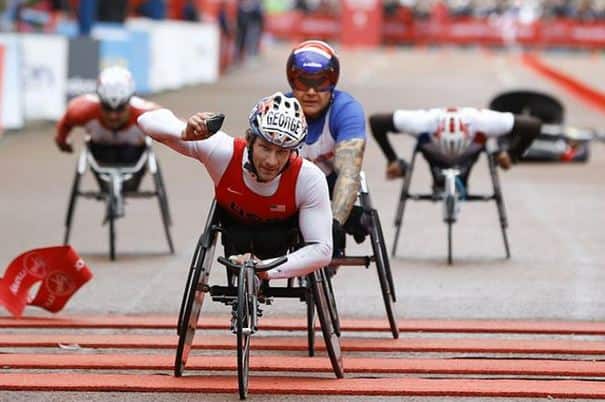 Among the wheelchair racers in the London Marathon in 2015, the USA’s Joshua George beat Britain’s David Weir to the line. (Image: London Marathon)
Among the wheelchair racers in the London Marathon in 2015, the USA’s Joshua George beat Britain’s David Weir to the line. (Image: London Marathon)
“I’ll listen to music and use the RunSocial app on my iPad to keep things interesting. As I run, the iPad displays a virtual landscape that moves by at my running pace. RunSocial has filmed my favourite running route near the village of Comrie in Scotland so I can go for a 10km run up Glen Artney whenever I feel like it. It will be great to feel a connection to planet Earth and to see the beautiful Scottish scenery whenever I do the route.”
“My fitness regime is designed to make sure I’m in good shape when I arrive back on Earth so I hope to be back on the trails soon after I return in May. I’d love to run the 2017 London Marathon – it will give me a great incentive to go through the rehabilitation and get myself fit again.”
Video – Time Peake prepares for London Marathon
British astronaut Major Tim Peake trains for the London Marathon 2016. He and colleagues on Earth have devised a special system involving a treadmill, harness and tethers so he can run the race.
